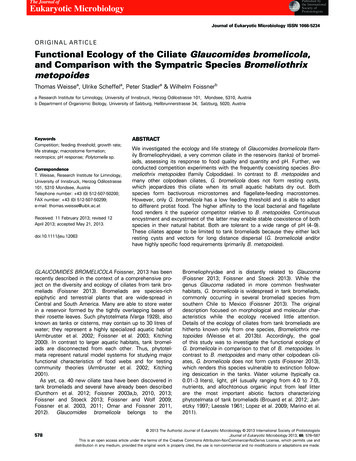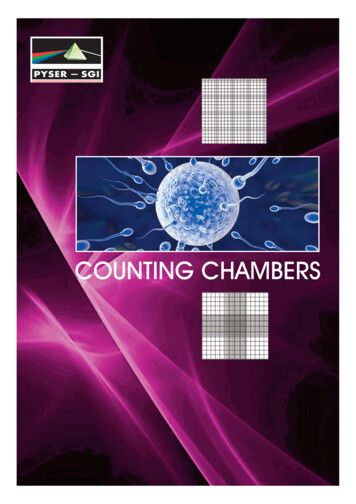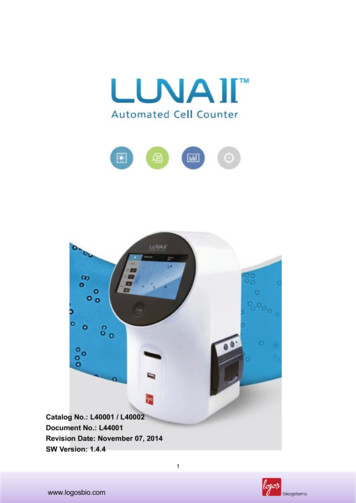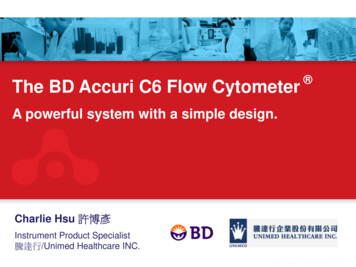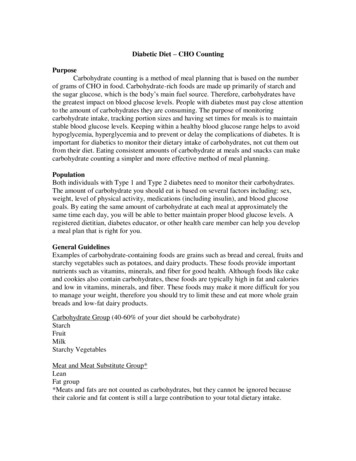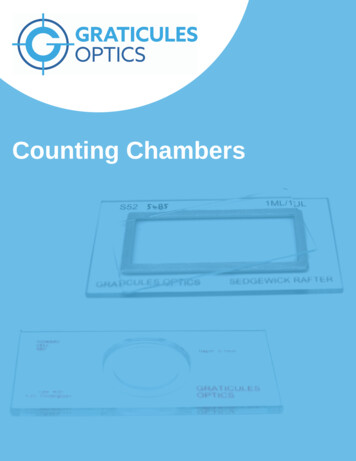
Transcription
Counting Chambers
02sedgewick rafter cellS50 - plastic sedgewick rafter counting chamberpatternS50descriptionorder codeSedgewick Rafter Counting Chamber[plastic] Includes 1 cover glass02C00415key featuresPlastic - economically priced celldescriptionAn economically priced cell, for one time (or possibly several time) use and for educational/training exercises.Generally we do not recommended the S50 plastic version for the professional user. The softness of the plastic means it is easilyscratched and otherwise damaged. However most laboratories who do use the plastic version see it more as a "throw away" orconsumable, which may best suit certain applications.S52 - glass sedgewick rafter counting chamberpatternS52descriptionorder codeSedgewick Rafter Counting Chamber[Glass] Includes 1 cover glass02B00417key featuresGlass - Professional CelldescriptionA serious reusable tool for the professional user. The cell is made of high quality optical glass with a chromium surface image. It isintended for continued professional use and whenever using phase contrast.S51 - spare coverglass for pyser optics sedgewick rafter counting chamberpatternS51descriptionorder codeCover glass for use with bothGlass & Plastic Cells02C00416key featuresFor use with both Glass & Plastic CellsdescriptionBothPyser Optics Plastic and Glass Sedgewick Rafter Cells are supplied with a cover glass. Additional spare cover glasses areAdditionalavailable to order from stock, as this S51.
03sedgewick-rafter filling method & usageThe cell can be used with either living or preserved material. To fill the cell, place the cover glass across the chamber top (Fig A). Thisallows the air bubbles to escape during the filling procedure. The sample is then taken into a 1ml wide mouthed pipette and thencarefully transferred to the chamber.Do not overfill the chamber, because the volume of the sample in the chamber must be known exactly and the cover glass must notfloat free, but held onto the cell walls by surface tension. During counting, water may evaporate from the chamber. To prevent gasbubble formation, a small drop of distilled water may be placed on the slide outside the cell, just touching the cell wall and coverglass. Before the cell count is made the Sedgewick-Rafter chamber should be allowed to stand for at least 15 minutes to allow algae,or other particles, to settle to the bottom.The Grid Pattern in the base of the chamber assists the counting and calculation process, by clearly defining a known sample volumein 1μl blocks Counting in strips is easier, no need to use reticle grids or know the precise area of your field of view.This makes Pyser Optics’s S50 & S52 Gridded Sedgewick-Rafter Cell perfect for use with a Stereo Zoom Microscope without theneed to carefully set the precise zoom/magnification before counting the sample.For precise sample preparation and calculation methods, you should follow your own internal or published procedures.cleaning methodTo clean the counting chamber: After completing the count, remove the cover glass and clean the counting chamber with water or amild cleaning solution (10% solution of bleach). Dry the counting chamber with a soft cloth or wipe, or rinse with acetone.
04howard mould counting cellGraticulesThe Pyser OpticsOptics S60 Howard Cell and associated K20 Cover Glass, is used world wide for mould counting in food quality controlapplications, such as tomato products and other fruit based preparations.GraticulesGraticulesOpticsOpticsS60 Howard Cell is based on the method originally developed by B.J. Howard in 1911, primarily for the purposePyser Optics’simprovedof monitoring tomato products, using a microscope.The special S60 Howard Cell chamber slide in conjunction with the K20 Cover Glass is designed to count mould mycelia.The S60 Howard Cell is a glass slide 76mm x 35mm with a central circular island and is used for counting mould fibres and spores infruit juices especially from tomatoes. With the K20 cover glass in place a 0.1mm thickness of liquid is contained over the central island.The cover glass has 25 calibrated fields of 1.382mm diameter through which to view the particles.This cover glass removes the necessity of precise adjustment of the microscope magnification and calibration of a special eyepiecereticle in the original Howard Method, making it suitable for use with a modern zoom stereo microscope as well as a conventionalcompound microscope.Note: The complete system requires both the cell itself and cover glass. The cell does not come with a cover glass and one must beordered separately. We recommend ordering one or two extra cover glasses, this way there is always going to be one in reserve.S60 - howard cell for fruit juicespatternS60descriptionorder codeHoward Cell for Fruit Juices02C00419key featuresSpecial Chamber for use with K20 windowed cover slip to count mould fibresand sporesdescriptionThe S60 Howard Cell is a glass slide 76mm x 35mm with a central circular island and is used for counting mould fibres and spores infruit juices especially from tomatoes. With the K20 cover glass in place a 0.1mm thickness of liquid is contained over the centralisland.K20 - cover glass for Pyser Optics howard cellpatternK20descriptionorder codeCoverglass for Howard Cell02C00420key featuresFor use with S60 Cell to hold a 0.1mm thickness of liquid for analysis andpresent known sample volumes for countingdescriptionWhen used with the S60 Howard Cell, the K20 cover glass holds in place a 0.1mm thickness of liquid is over the central island for analysis.The cover glass has 25 calibrated fields of 1.382mm diameter through which to view the particles.This cover glass removes the necessity of precise adjustment of the microscope magnification and calibration of a special eyepiecereticle in the original Howard Method, making it suitable for use with a modern zoom stereo microscope as well as a conventionalcompound microscope.
05how to use a howard cell - general procedureThe material to be examined should be a pulp. Mix a small quantity with water until the solids of the diluted pulp are between 8.37% and9.37%. This corresponds to an Abbe refractometer reading at 20ºC of 1.3460.Spread a small drop of the well-mixed sample with the end of a glass rod over the counting chamber.Place the cover glass on to the counting chamber and carefully press down the shoulder of the chamber until Newton’s rings are visible.Prepared samples containing air bubbles beneath the cover glass or an over-full moat should be discarded.If using a compound microscope, examine using the X10 eyepiece and the X10 objective.If using a compound microscope, examine using the X10 eyepiece and the X10objective.Systematically examine all 25 fields and note those with a presence or absenceof mould filaments (hyphae).A field is regarded as positive if the aggregate length of not more than threefilaments present exceed one sixth of the diameter of the field.This is a general description of how a Howard Cell is used. The results areinterpreted as a percentage of positive fields observed in all the fields examined.Precise interpretation of the results is made by a statistical analysis of the sampleand should be carried out in accordance with your own internal or publishedprocedures.howardmould counting cellMaklerChamberThe Makler counting chamber is only 10μm deep, which is one tenth the depth of other Haemocytometers, making it the shallowestof known chambers.This quality chamber is constructed from two pieces of optically flat glass: the first is the chamber, the second the cover glass whichhas a fine grid pattern of 1mm squares and a centre area further subdivided into 0.1mm squares.Four quartz pins of precise height hold the cover glass to give an exact trapped specimen depth of 10 μmmakler chamberpatternMaklerdescriptionorder code0.01mm deep Semen Counting Chamber02C00645
07haemocytometry counting chambersmalassez double cellpatterndescriptionorder codeMalassezDouble Cell 0.2mm02C00600key featuresFor Haemoglobin and Lucocyte countsdescriptionStandard French Rulingmalassez single cellpatterndescriptionorder codeMalassezSingle Cell 0.2mm02C00601key featuresFor Haemoglobin and Lucocyte countsdescriptionStandard French Rulingthoma double cellpatternThomakey featuresdescriptionorder codeDouble Cell 0.1mm02C00605For Haemoglobin and Lucocyte countsdescriptionStandard German Ruling
08haemocytometry counting chambersthoma single cellpatternThomadescriptionorder codeSingle Cell 0.1mm02C00606key featuresFor Haemoglobin and Lucocyte countsdescriptionStandard German Rulingneubauer double cellpatternNeubauerdescriptionorder codeDouble Cell 0.1mm02C00610key featuresFor Haemoglobin and Lucocyte countsdescriptionModified Thoma Rulingneubauer single cellpatternNeubauerkey featuresdescriptionorder codeSingle Cell 0.1mm02C00611For Haemoglobin and Lucocyte countsdescriptionModified Thoma Ruling
09haemocytometry counting chambersimproved neubauer double cellpatternImproved Neubauerdescriptionorder codeDouble Cell 0.1mm02C00616key featuresFor Haemoglobin and Lucocyte countsdescriptionRuling allows full use of central squaresburkerpatternBurkerdescriptionorder codeDouble Cell 0.1mm02C00626key featuresFor Haemoglobin and Lucocyte countsdescriptionFor counts in bandsthoma double cellpatternThomakey featuresdescriptionorder codeDouble Cell 0.1mm02C00605For Haemoglobin and Lucocyte countsdescriptionCompletely Decimal
11parasitology, cytology & other chambersnageotte double cellpatternNagoeottedescriptionorder codeDouble Cell 0.5mm02C00630key featuresFor Urinary cytology, cephalo-rachidien fluid analysisdescriptionFor liquids in poor content (French)nageotte single cellpatterndescriptionorder codeNageotteSingle Cell 0.5mm02C00631key featuresFor Urinary cytology, cephalo-rachidien fluid analysisdescriptionFor liquids in poor content (French)Lemaur Single Cellpatterndescriptionorder codeLemaurSingle Cell 0.4mm02C00635key featuresFor Urinary cytology, cephalo-rachidien fluid analysisdescriptionImproved Nageotte with smaller volume
12improved mc master double cellpatternMcMasterdescriptionorder codeDouble Cell 1.5mm02C00650key featuresChamber is ruled with 2 x 1cm squares,each with 10 equal distance vertical linesforming 10 mm squares with 10 equalvertical columns.ParasitologydescriptionWorm egg countinghelber single round cellpatternHelberdescriptionorder codeSingle Round Cell 0.02mm02C00655key featuresBacteriadescriptionSlide 1mm thick with Thoma Rulingevaluation single round cellpatternEvaluationdescriptionorder codeSingle Round Cell 0.02mm02C00660key featuresBacteriadescriptionSlide 1mm thick - no ruling
13parasitology, cytology & other chamberssemen single round cellpatternFertilitydescriptionorder codeDouble Cell 0.5mm02C00630key featuresFor Urinary cytology, cephalo-rachidien fluid analysisdescriptionFor counting untreated semen. Ruling of 10 x 10 of 0.1mm squaresagasse lafont B single cellpatternAgasse-Lefont Bkey featuresOtherdescriptionCompletely decimaldescriptionorder codeSingle Cell 0.003mm02C00675
S52 - glass sedgewick rafter counting chamber key features A serious reusable tool for the professional user. The cell is made of high quality optical glass with a chromium surface image. It is intended for continued professional use and whenever using phase contrast. description sedgewick rafter cell 02 For use with both Glass & Plastic Cells S51




